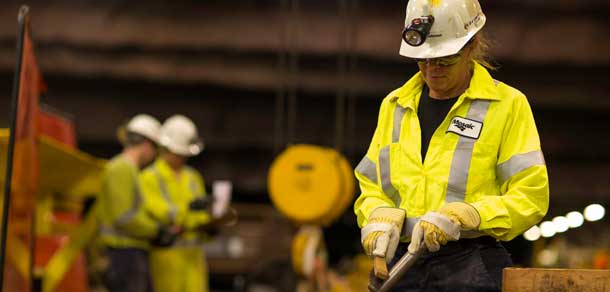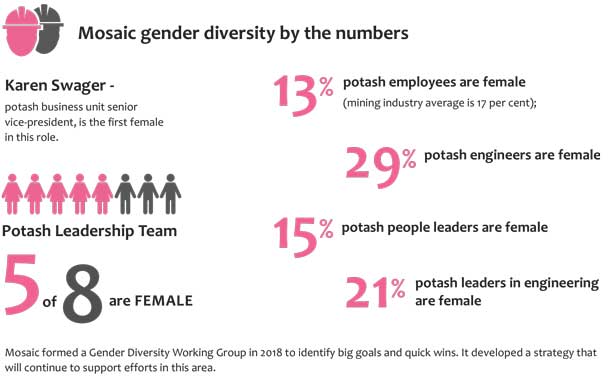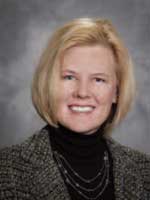Jessica Theriault, P.Eng. was the first female chair of the SMA board.
Jessica Theriault, P.Eng.
Young, bright and driven – Jessica Theriault knew she belonged. She wasn’t deterred despite being amongst the minority.
While studying at the University of Regina, where she obtained an environment engineering degree, Theriault was one of the few females in the engineering classroom, easily outnumbered by her male classmates.
Little did she know at the time, however, that by continuing along her path that she would make history in the Saskatchewan mining industry.
Heading Up SMA
In March 2019, Theriault concluded her two-year term as chair of the board of directors for the Saskatchewan Mining Association (SMA). It was the first time in its 50-plus-year history the association that represents this province’s mining sector has seen a female chair.
“It definitely exposed me to the broader side of the business, which was more in alignment with my recent MBA,” Theriault explained. “I’ve always needed to be technical and regulatory-focused in my role, so this gave me the opportunity to have a deeper look into the business side of mining and its impact on the province and the provincial economics and on the role that mining plays in Saskatchewan.”
It is a position, she says, she would love to take on again should the opportunity arise. Theriault remains on the board of directors, along with three females (Alice Wong from Cameco Corp., Crystal Steciuk with Mosaic and Nicole Powlowski with K+S Potash). Tammy Van Lambalgen (Orano Group) is now serving as chair of SMA board.
Theriault is the director of regulatory affairs with The Mosaic Company. With more than 20 years of environmental experience in the potash mining industry in Saskatchewan, she oversees the coordination and management of environmental regulatory relations for Mosaic’s potash business unit, as well as leadership in the development of the Mosaic Potash Business Unit Sustainability Program.
An impressive resume, indeed. So why did it take 50-plus years for a woman to sit as chair at SMA?
“There have been women who have played leadership roles in mining for several years … I don’t think there is any one particular reason why (it took 50-plus years for a woman to serve as chair) because there are several examples in Saskatchewan of women in very senior leadership roles within the mining industry,” Theriault said.
She immediately pointed to Pam Schwann, president of SMA, as one example. Theriault was proud of her appointment to chair of the board at SMA and grateful to the other women like Schwann who helped paved the path to leadership within the industry.
“There are many more (female leaders) in the mining industry,” she said. “I had a lot of support from Mosaic, from Pam and from the board of directors. They helped to provide guidance and advice along the way. A great team to be a part of.”
Sign of Change
Certainly, her appointment to chair garnered headlines. The mining sector, and engineering in general, has largely been a male-dominated industry for decades, although Theriault has seen gender diversity greatly improve over the past 20 years.
Engineers Canada has made recruitment, retention and development a top priority. It has been working to increase the representation of women within engineering through its 30 by 30 initiative – with a goal of raising the percentage of newly licensed engineers who are women to 30 per cent by the year 2030. Thirty per cent is viewed as a tipping point for sustainable change.
As a university student, Theriault said the majority of her work terms were with pulp and paper. She completed two terms at a mill in Thunder Bay, ON. After university, her first year of employment was in the oil and gas sector as a wireline field engineer, prior to moving over to mining.
“In university, I was used to being one of the few females in the classroom,” she said. “But now, the times and the number of women working in the field have definitely changed. There are a lot more females working in the mining industry and in engineering overall.”
“When I first got involved in engineering, females were the minority. Working in the pulp and paper sector, females in engineering and females in general within the mill were a minority as well. The same statement can be made for my experience as a wirelike engineer in the oil and gas sector. I was used to being a minority in the workforce coming into IM Potash (at the time) in 1998, but that is definitely not the norm now.”
Rewarding Career
Following her brief tenure in the oil and gas sector, Theriault found herself at the potash mine in Esterhazy. Her first year at Mosaic’s IM Potash she worked in strategic alliance as a technical analyst on the procurement side before she eventually moved into environmental work, which is her background.
She will celebrate 22 years with Mosaic in May 2020.
Looking Ahead
Thanks to an ever-evolving business, Theriault says her exact future career in mining is somewhat of an unknown. Although her heart would love to stay immersed in the environmental and regulatory aspects of the industry, she’s always looking for new challenges and thrives on being challenged.
She noted the role she’s in today didn’t exist a handful of years ago and she’s almost certain the role she retires in might not exist today.
Theriault is, however, convinced of one issue she’d like to address in the immediate future.
“I want to make sure our younger entrants into this field are set up for success and that they are mentored and supported as much as I was early in my career,” she said. “I want to pass along that same level of effort to the next generation to make sure they’re successful in their roles.”
Women making inroads in mining sector
Karen Swager
Karen is registered as a professional engineer in the U.S., and as a newcomer to Saskatchewan, she is in the process of becoming registered with APEGS.
When Mosaic’s Senior Vice-President Karen Swager was in college, only one in five students in her engineering program were female. That number dropped even more precipitously when she was in graduate school.
“I didn’t think that much about it at the time. I went into engineering with my eyes open knowing that it was a male-dominated profession. I knew what I was getting into. In any case, even with that imbalance, universities tend to be more modern and inclusive in their thinking, so I didn’t really find it a barrier at that time,” Swager said.
Changing Attitudes
She found it harder when she entered the workforce.
“My first full-time job was at a mine. No one there had ever worked for a woman before. Even today, that’s still very often the case.”
This wasn’t always a negative. Swager says that, in some situations, she had lots of support from peers and employees making special effort to be modern and inclusive. Other situations, not so much.
“On one of my first projects, I was supervising contractors. I gave instructions to a foreman who said, ‘sorry I need to get that from a boss man’. As an inexperienced 24-year-old professional, I found it difficult to figure out how to tackle that problem. Ultimately, I had to take the matter to a higher-level manager who had the foreman removed from the job.”
Over the decades, Swager has seen significant change for the better.
“There are more females at high levels in the mining industry. Their paths haven’t been easy, but they’ve made it and their success has encouraged others.”
She notes that the potash industry, while still nowhere near gender parity, has done better than in some other engineering fields.
“In potash, about 13 per cent of employees, 15 per cent of leaders and 29 per cent of engineers are female. We’ve made a concerted effort to reach that number but obviously we still have a long way to go.”
Swager notes that Mosaic actively recruits female engineers through its student programs and makes special efforts to ensure the company offers opportunities to females. The company has an internal working group on gender diversity to make the numbers better.
As for where to go in the future, Swager believes the issue needs to be addressed in schools.”
“I would like to see more exposure and encouragement in schools about engineering as a career option for girls. To change the game, we’ll have to do something different. Instead of just promoting in high school, perhaps we need to start earlier at middle school.
“Women engineers also need to tell our story better. We need more positive stories about women who have succeeded. That’s one place I’m always happy to contribute. I’ve loved the profession.”



